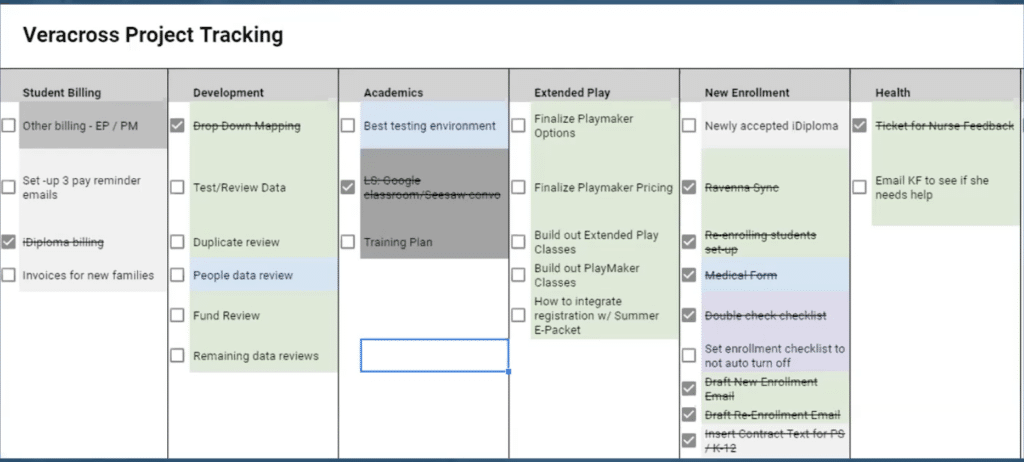
Located in Atlanta, GA, Mount Vernon School is a Pre-K through grade 12 independent day school with 1,100 students. They implemented Veracross in 2020 as a way to streamline data management and improve the parent experience. Keep reading to learn how they approached a school-wide software change.
Managing the People
Courtney Stillwagon was the designated project manager for the SIS implementation. As the school’s Director of Finance and Corporate Controller, Stillwagon may seem like an unlikely candidate for such an initiative; however, her unique perspective allowed her to see the bigger picture and manage change on a school-wide level.
Stillwagon partnered with the Head of IT to navigate the SIS transition. They began by establishing roles and responsibilities for the initiative. Who should be on the implementation team? Who is responsible for each module? Once ownership was assigned for each project phase, it was communicated to the broader staff.
Upon reflection, Stillwagon credits three factors to their successful approach:
An executive sponsor. Stillwagon relied on the school’s Chief Financial Officer for support. They met biweekly to discuss progress and identify roadblocks. “He was the person who would move anything along if there were problems and [was] our voice in the higher-level executive meetings,” says Stillwagon.
Backup support. Implementing a new SIS is a huge project — much less when you already have a full-time job! At Mount Vernon, Stillwagon had an assistant that helped with day-to-day tasks related to the business office so she could focus on the implementation. “That may be one of the biggest keys to success,” says Stillwagon. “As you’re rolling this out, there’s obviously still your entire job that’s there to do that can’t wait most of the time. That [was] really key.”
Shared motivation. Last but not least, Stillwagon credits much of the project’s success to internal buy-in and enthusiasm. “Everyone had been dealing with a number of different systems for years… And the behind-the-scenes of making sure the data agrees to each other within multiple systems was becoming very taxing on the business side,” adds Stillwagon. “Everybody was on board with the idea behind getting onto one system, which made it a lot easier when you ‘volun-told’ somebody what their role was.”
Managing the Project
Once roles and responsibilities were assigned, Stillwagon created a project tracker in Google Sheets to keep track of tasks and progress. “We looked at implementing some larger project [management] systems… but we decided to [use] what everybody knew well already,” she adds.
The project tracker was broken down by module and color-coded based on ownership. Everyone involved in the implementation had access to the tracker for transparency. Stillwagon was responsible for updating the tracker and checking in with team members about their respective tasks, due dates, or blockers.
“I try to drive everybody back to this,” says Stillwagon. “Any time we have our weekly meetings, this is where we start. When I update our CFO on a biweekly basis, I go through this [tracker] with him. It’s what everybody refers back to.”
Managing the Communication
From beginning to end, clear communication was critical for setting and meeting project expectations both internally and externally.
On the vendor side, Mount Vernon began with an internal conversation about their ideal timeline for launching the Veracross SIS. Once they identified their drop-dead dates, they communicated that to the Veracross implementation team and aligned on what tasks needed to happen when for a smooth implementation. Throughout the implementation process, Stillwagon was mindful about voicing concerns within reason. “Don’t be afraid to voice your concerns, but prioritize them,” she says. “I try really hard not to over escalate things that don’t need to be over escalated so that they know if I say, ‘I’m sweating the timeline on this,’ they know I’m not just crying wolf.”
With her internal team, Stillwagon relied on email communication to keep staff informed about roles, responsibilities, and timelines. She sent a high-level breakdown of each project phase, team lead, and overall best practices to ensure a smooth implementation. “The goal was to clearly communicate who was doing what… but there’s also an ask,” says Stillwagon. “Our expectation of every person on this email is that you are an ambassador of the new tool. [Or] if you think that there is someone that should be included who’s not, let’s talk about it.”
They were also very intentional about how they communicated the SIS change to families. Stillwagon opted to overcommunicate and focused on the benefits of Veracross for students and parents. “We know that you are fatigued in a number of different systems and we are addressing that. This is the only place you will have to go moving forward,” reflects Stillwagon. By focusing on the good news, it helped everyone (both internally and externally) navigate the transition with relative ease and not get bogged down by the process.
Managing the Expectations
The combination of healthy communication, thorough project management, and clear roles and responsibilities allowed Mount Vernon to see the SIS transition to fruition. The result? A happy implementation team and even happier families.
“Our success was directly linked to our parents being happy,” says Stillwagon. “And they directly told us that decreasing their number of systems made for a much better experience.”
To learn more about Mount Vernon’s experience implementing the Veracross SIS, watch this on-demand webinar.




